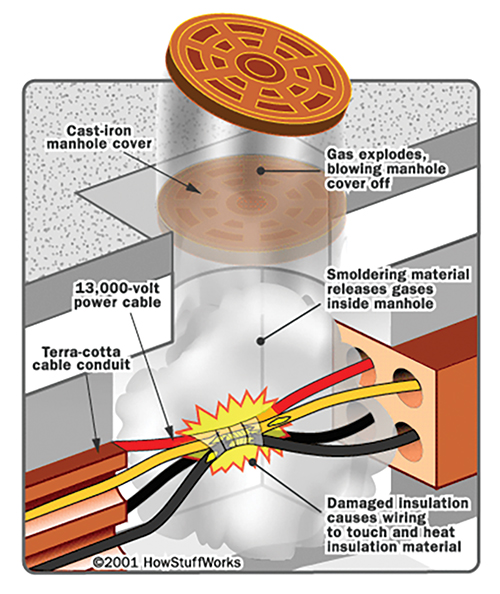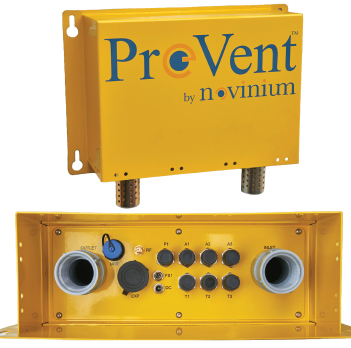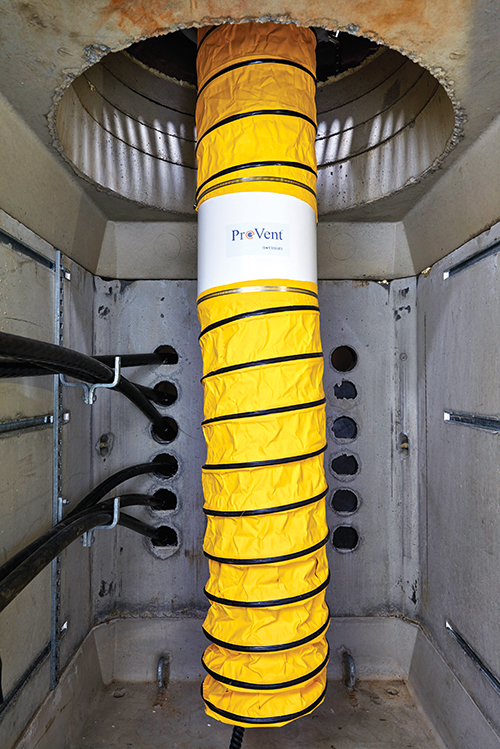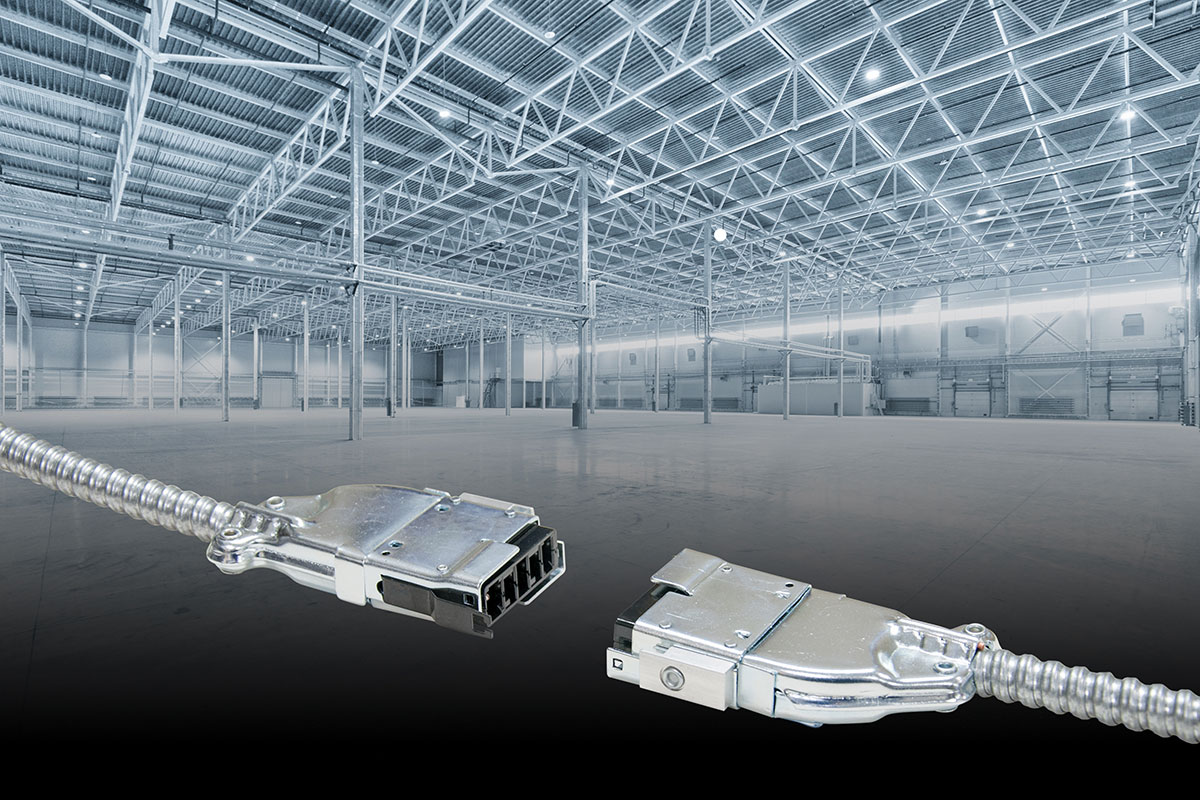Utility companies rely on manholes, the street-based access vaults for electrical and other infrastructure, to make upgrades and repairs to the various underground systems that link buildings and neighborhoods. The vaults occupy only a semi-protected space in urban environments: sheltered somewhat from the elements, but still subject to decay caused by environmental changes over time.
When a manhole vault reaches a point of dangerous climatic conditions—such as the severe fault of electrical cables and accessories causing rapid vaporization, resulting in combustible gases—a manhole event can occur, generating smoke, fire, or even an explosion. In the most catastrophic events, explosions damage the inside and top of the structure or the road above it, sending the manhole cover flying into the air. The resulting damage can be devastating, both to human safety and to utility operations as they scramble to restore services, as well as to absorb the financial damage, logistical hassles, and public scrutiny caused by the event.
An escalating safety issue
Across North America, an estimated 2,000 manhole events occur each year, an average of 5.5 events per day. With the current state of aging infrastructure in most cities, this frequency is likely to increase unless utility companies take preventive measures. To do this, the utilities require a clear understanding of the causes of manhole events and the methods available for addressing them before they happen.
Many utilities lack visibility into the conditions of their manhole vaults. The sheer number of vaults in a typical municipality makes it unrealistic to schedule even the most cursory regular observation. Even when technicians visit a vault, unless equipped with an array of sensory equipment, it’s unlikely they will identify every dangerous condition.
Overall, the problem of manhole events is manifest in three major areas of concern to utilities:
- Public safety – at their least damaging, explosive manhole events cause service disruptions that indirectly impact nearby public safety procedures and over-stresses neighboring cables; at their worst, they cause bodily harm through the projection of manhole covers into pedestrian and automotive traffic.
- Technician safety – field technicians who are dispatched to contain a manhole event face an increased risk of injury, both from the accumulation of toxic gases that caused the event and the uncertain (and often unsafe) working conditions during issue resolution and repair.
- Utility operations – the operational mitigation and repair costs to public utilities when an explosion occurs can reach $100,000 per manhole, with untold additional cost in the form of liability litigation and public relations impacts resulting from injuries caused.
How manhole events happen
Manholes are harsh environments. As subterranean equipment vaults, they are exposed to outside elements including severe pollution from natural debris, vegetation, human trash, automobile fumes, acid rain, and high concentrations of salt and fresh water. Most manhole events happen in winter due to increased exposure to water, salt, and debris that permeates the manhole vault from above and affecting electrical, gas, and water infrastructure that has already been damaged by traffic vibrations, rodent invasion and the ravages of age.
These collective conditions regularly create micro-environments that are hostile or lethal to humans and capable of damaging or destroying the equipment and constructions contained within the underground structures. Toxic gases are created through the breakdown and decomposition of materials used inside the networks of vaults, as well as those introduced into the vaults, such as the disposal of gasoline or other toxic chemicals.
Interconnections with adjoining structures exacerbate the issue, as electrical manholes often cross sewer or natural gas pipes in such spaces, amplifying the risk of electrical ignition and explosion when a leak from one of these nearby conduits occurs.
Manhole events can have multiple contributing factors. One extremely common type of event is the decomposition of electrical insulation in an anaerobic environment which produces flammable gases such as carbon monoxide (CO). Other causes of flammable gases include the public disposal of combustible materials that find their way into manholes or because of decaying organic material that has fallen or been washed into the vault. Combustible gases can accumulate inside manholes as a result of gas line leaks or from sewage systems that are frequently routed through or near other underground structures.

Important safety considerations: protection and prevention
Safety when addressing manhole events comes down to protection and prevention. On the protection side, technicians must be aware of the dangers of entering a vault that has a potentially lethal mix of conditions for creating an event. Needless to say, they must take even more care entering a vault after an event has already occurred. The following technician protection considerations are recommended:
- Use appropriate PPE – in addition to standard personal protective equipment, including hard hats, vests, and fire-resistant clothing, manual inspections also require gas test meters, rescue tripods, and air blowers, particularly in cases where a clear danger of a manhole event exists.
- Plan for adequate resources – a typical inspection crew is 2-3 technicians, all of whom should be budgeted and outfitted for appropriate PPE protections. In many cases, public and technician safety should be further ensured by providing traffic control to keep cars and pedestrians away from the work area and technicians.
- Capture all data – using their firsthand observation of the vault conditions and the sensory equipment they bring along, the crew should develop a report on the state of the manhole, with an assessment of risk for a future manhole event and proposed mitigation actions, if any.
However, manual inspections aren’t always safe or practical, no matter how many protections are applied. Prevention is the preferred tactic for most utilities, from an operational, budgetary and common-sense standpoint. But how to achieve it? Many utilities understand the danger and repercussions of manhole events, but lack a plan for addressing them before they occur.
Few solutions have arrived on the market to address this need, and almost none have done so from a holistic, preventive perspective. “Locking” manhole covers that secure from below and prevent the covers from going skyward are now common, reducing the risk of injury from a flying cover above ground, but this is still a reactive measure—it only helps contain damage after an event has taken place.

Active monitoring and risk reduction
The key to being proactive about manhole events is monitoring each individual vault for conditions that are likely to cause an event. By instrumenting the vaults to watch for a wide range of environmental factors, and then calculating and reporting on specifically dangerous combinations of those factors, utilities can get warnings and act before public safety or the infrastructure itself is impacted.
With the frequency of manhole events and the severity of their impact on the rise, companies are stepping up to address the issue of systematic prevention. For example, as part of its patent-pending PreVent™ manhole protection solution, Seattle-based Novinium offers an active monitoring system that helps utilities get a holistic view of environmental conditions throughout their manhole vault networks.
The PreVent™ active monitoring system predicts events before they occur and transmits real-time alerts to utility technicians, sending the necessary information for them to address specific event symptoms in a precise location. A variety of sensors pinpoint the source of the problem in real-time, while a central console displays instructions to the utility so it can contain the risk, protecting itself and the public from a potentially catastrophic event. PreVent™ is customizable for different needs, from selecting the level of monitoring capability to choosing how alerts are communicated and displayed.


Other PreVent™ components, including active venting systems for manhole vaults and water intrusion limiting covers, that work proactively to limit each manhole’s exposure to water, salt, and debris, thereby reducing the risk of explosions and other manhole events caused by secondary cable failure. Used together, these components provide an end-to-end solution that equips utility companies to provide better safety throughout their aging manhole infrastructures and make better, data-driven decisions.
The capabilities of active monitoring continue to evolve, and will increase safety and productivity for utility field technicians by eliminating the increased chance of manhole events and handling issues before they occur. The benefits are clear: By using data, not just people, to track the environmental conditions across an entire network of manhole vaults—and by predicting failures rather than waiting for them to happen—utilities can gain efficiency in their operations and potentially save lives. As a welcome side benefit, they also stand a better chance of sidestepping the intense public scrutiny that typically accompanies manhole events or other related, unexpected occurrences.
Photo credit: Novinium
Photo illustration: How Stuff Works
Source: Novinium











Find Us on Socials